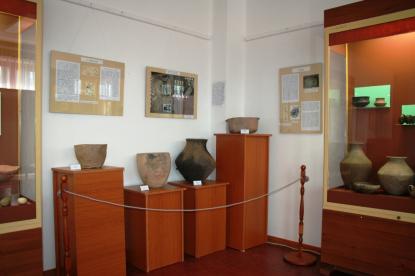2024. April 18. Thursday
Széchényi Ferenc Country Museum - Ebes
|
|
Address: 4211, Ebes Ady E. út 6-8.
Phone number: (52) 366-136
E-mail: ebesmuzeum@gmail.com
Opening hours: Tue-Fri 10-18, Sat 10-16
|
The exhibition has closed for visitors.
2012.03.15. - 2012.08.05.
Museum tickets, service costs:
|
Ticket for adults
|
600 HUF
|
|
|
Group ticket for adults
(from over 8 people)
|
400 HUF
|
|
|
Ticket for students
|
400 HUF
|
|
|
Group ticket for students
(from over 8 people)
|
300 HUF
|
|
|
Ticket for pensioners
|
400 HUF
|
|
|
Ticket for families
|
1500 HUF
|
/ family
|
|
Photography
|
300 HUF
|
|
|
Video
|
500 HUF
|
According to the known evidences, the area of Ebes was settled from the age of Middle Neolithics. This area between the valleys of Ágod, Zsong and Vér streams were capable for human sedentation. The conditions of life were given here: land protected from water, water and good soil for cultivation. The subgrade in Ebes is yellow clay, which is capable both for buliding houses with battered walls, and making pottery.

Human settling on the area of recent Ebes had begun approximately 6500-7000 years before present. We know the marks and heritages of different populations from archaeological excavations. The first finds were taken into inventory in the Déri Museum in 1909: a padlock and a spur, with the following notes: Both of them were found in the bounds of the ruined village Ebes. The planned researches started in 1988-89, with the excavation of Templomdomb and Templom-dűlő (Church Hill and Church Vineyard).
During the 2000's preceding excavations of building of the route Nr. 4. and the Ebes industrial park were made according to the law. In ocassion of these excavations, plenty of archaeological objects and finds came to light. This is the first time for these pieces to be seen by the public, in acquittance of the Széchényi Ferenc Museum.
The archaeological exhibition shows up six archaeological periods: the Neolithic, Iron Age, Age of Roman Empire, Period of Migrations, Age of Hungarian Conquest and Árpád Kings, and the Late Middle Age. The exposure continues at the lobby of the museum with a historical part, which follows with attention the improvement of Ebes from the 17. century up to our days. On the 60th anniversary of the village, the Széchényi Ferenc Museum would like to salute to the memory of our forbears, who lived and worked at this place, and built their settlement up again and again.
The showpieces are from the archaeological collection of the Déri Museum and the collection of the Széchényi Ferenc Museum.

Human settling on the area of recent Ebes had begun approximately 6500-7000 years before present. We know the marks and heritages of different populations from archaeological excavations. The first finds were taken into inventory in the Déri Museum in 1909: a padlock and a spur, with the following notes: Both of them were found in the bounds of the ruined village Ebes. The planned researches started in 1988-89, with the excavation of Templomdomb and Templom-dűlő (Church Hill and Church Vineyard).
During the 2000's preceding excavations of building of the route Nr. 4. and the Ebes industrial park were made according to the law. In ocassion of these excavations, plenty of archaeological objects and finds came to light. This is the first time for these pieces to be seen by the public, in acquittance of the Széchényi Ferenc Museum.
The archaeological exhibition shows up six archaeological periods: the Neolithic, Iron Age, Age of Roman Empire, Period of Migrations, Age of Hungarian Conquest and Árpád Kings, and the Late Middle Age. The exposure continues at the lobby of the museum with a historical part, which follows with attention the improvement of Ebes from the 17. century up to our days. On the 60th anniversary of the village, the Széchényi Ferenc Museum would like to salute to the memory of our forbears, who lived and worked at this place, and built their settlement up again and again.
The showpieces are from the archaeological collection of the Déri Museum and the collection of the Széchényi Ferenc Museum.
